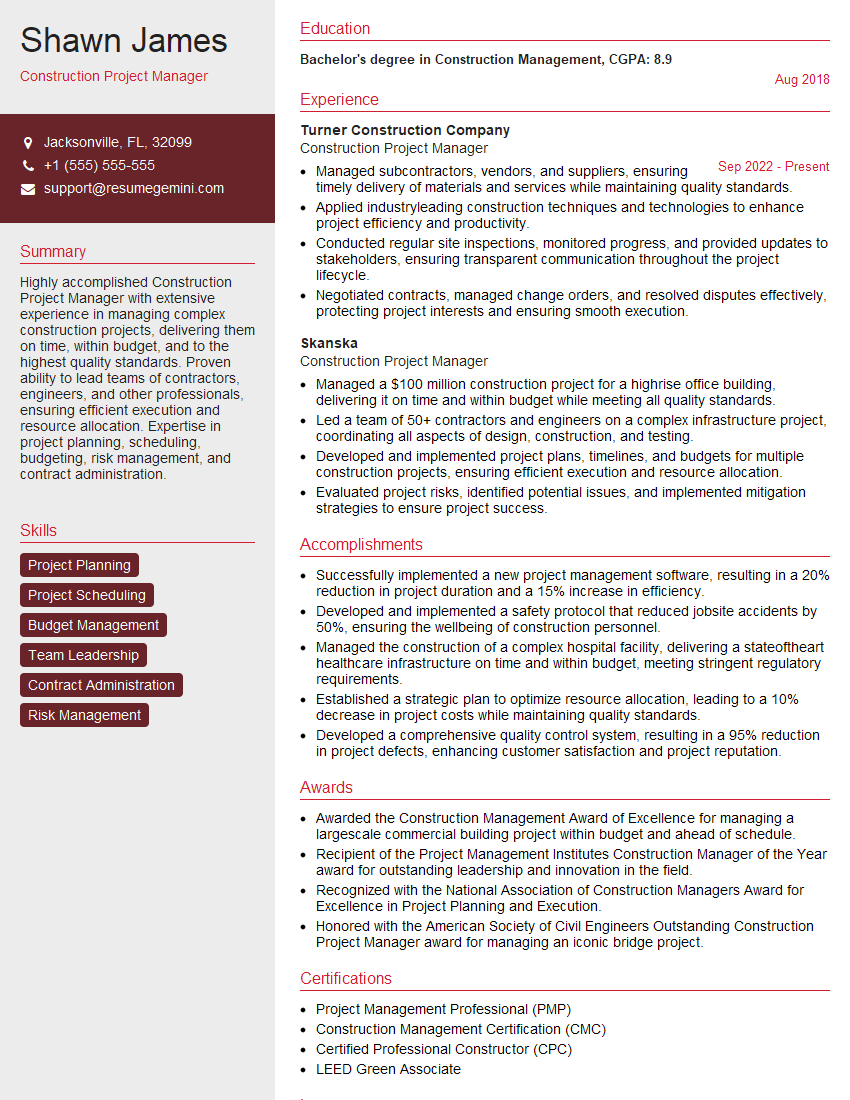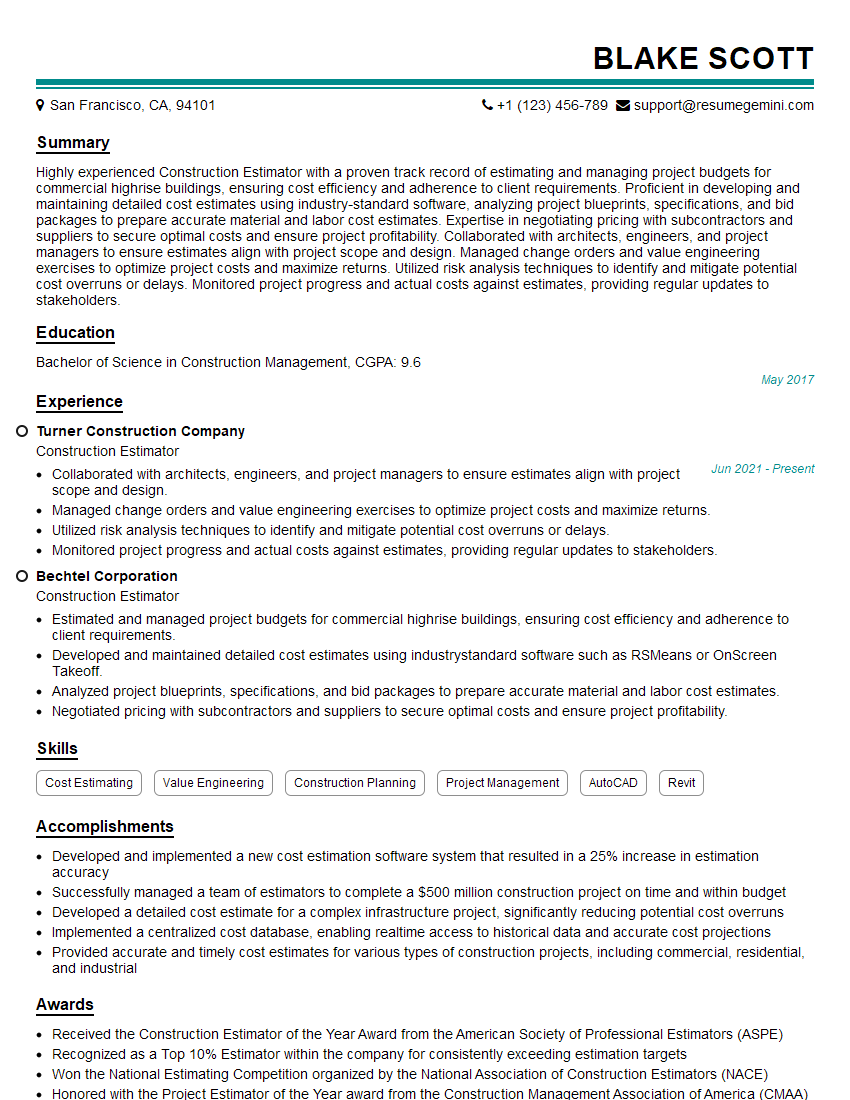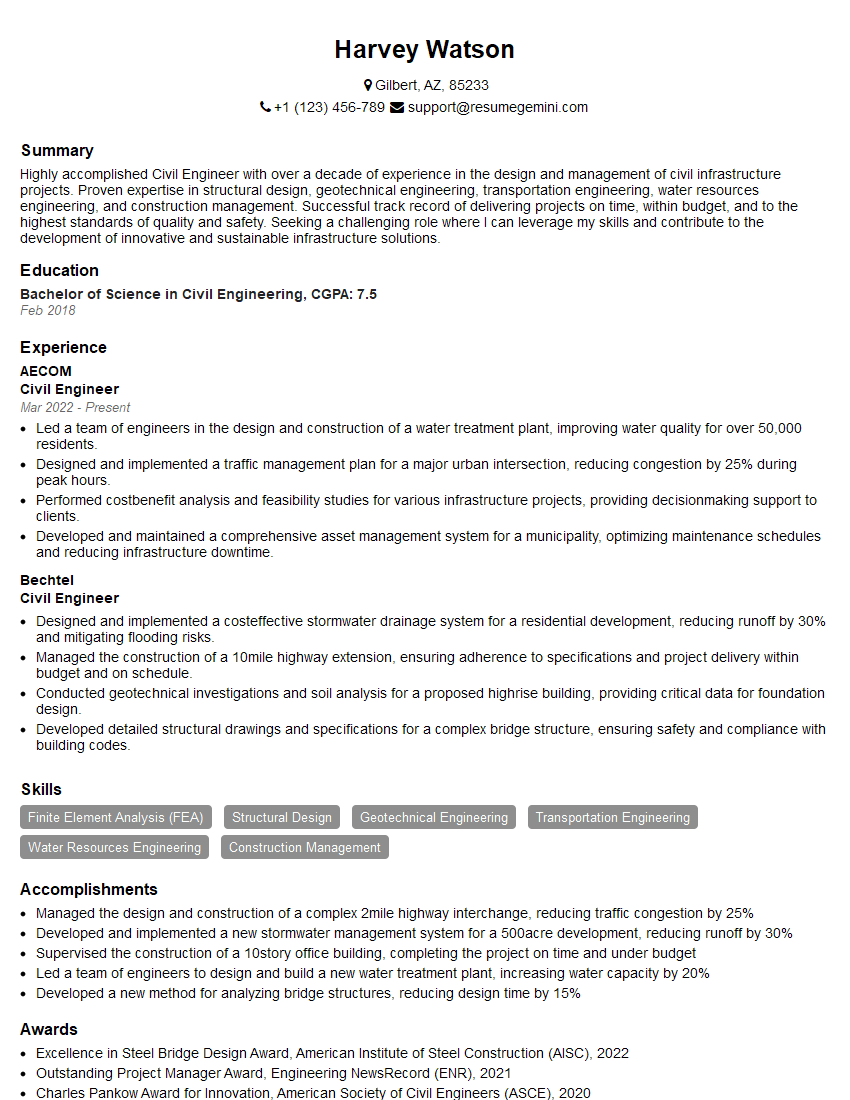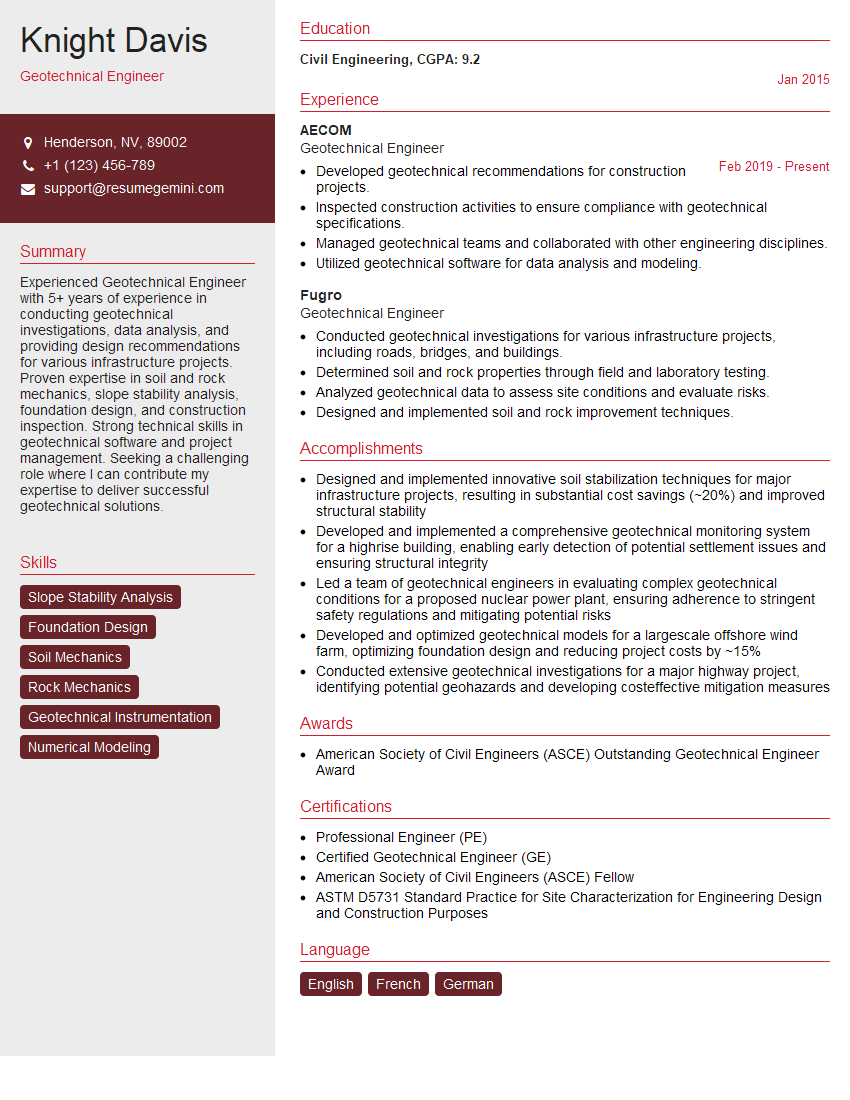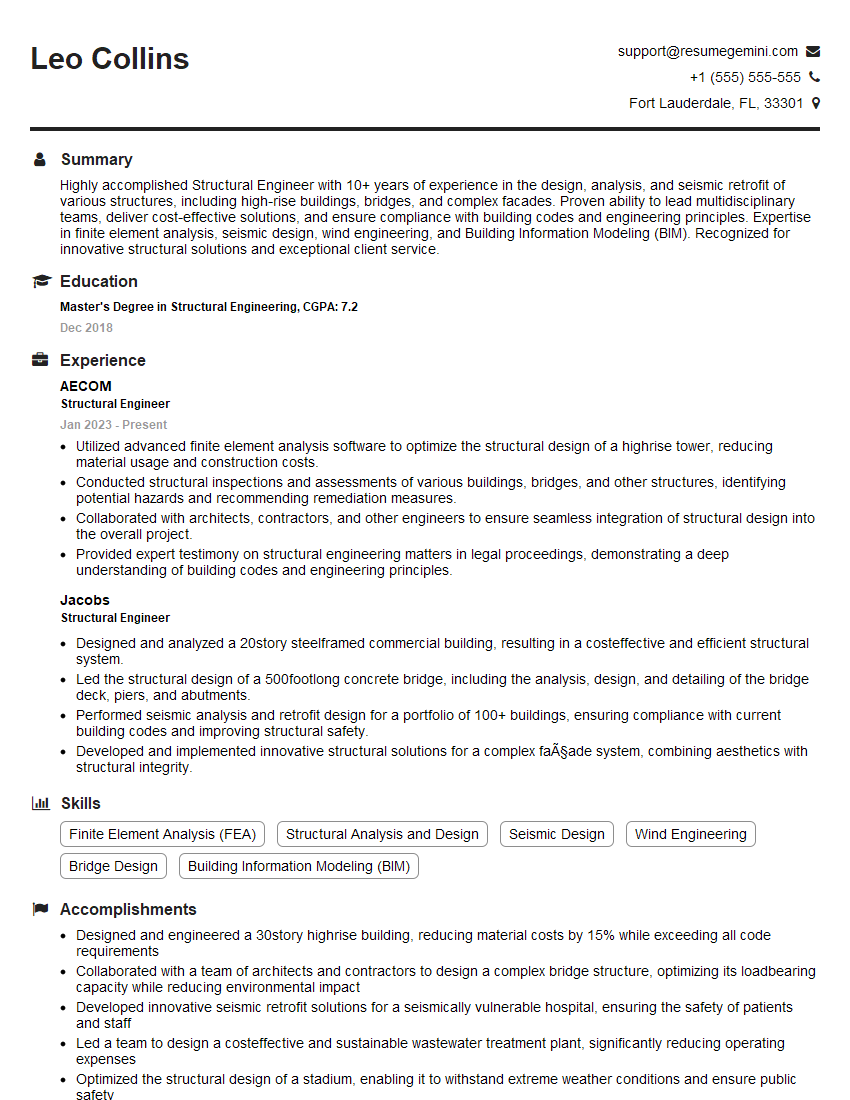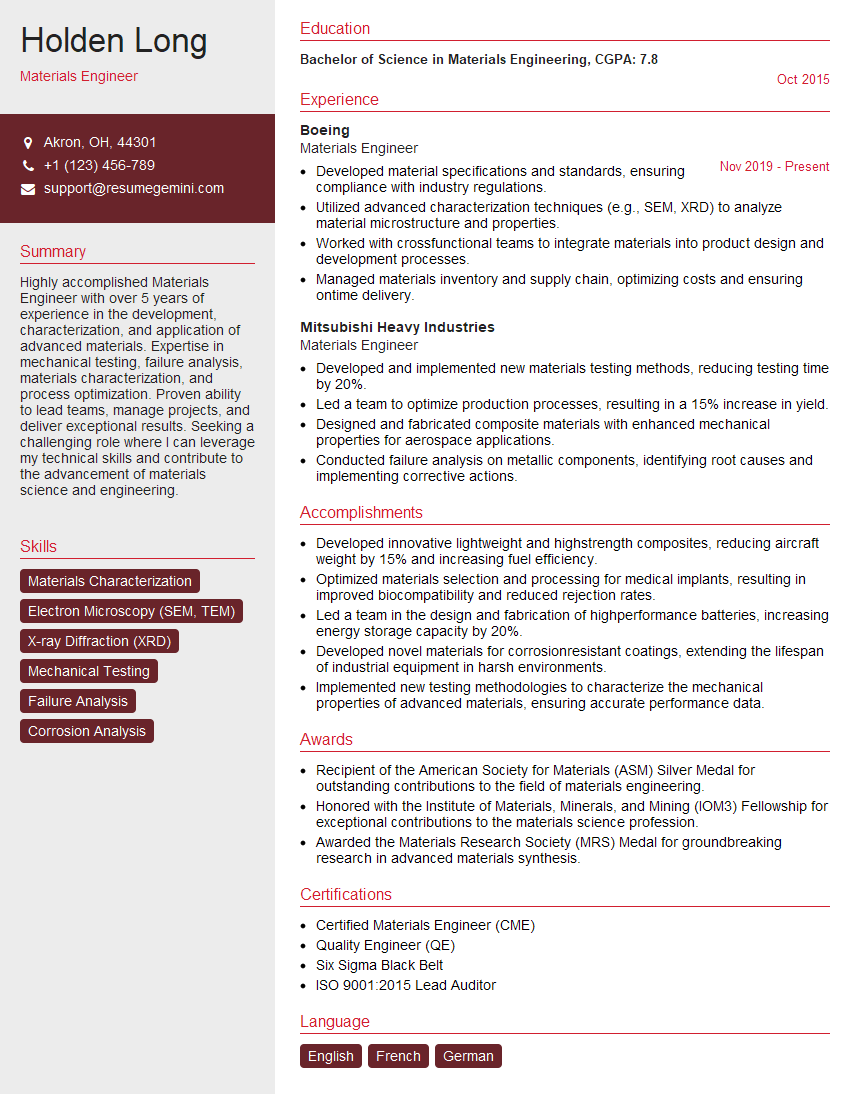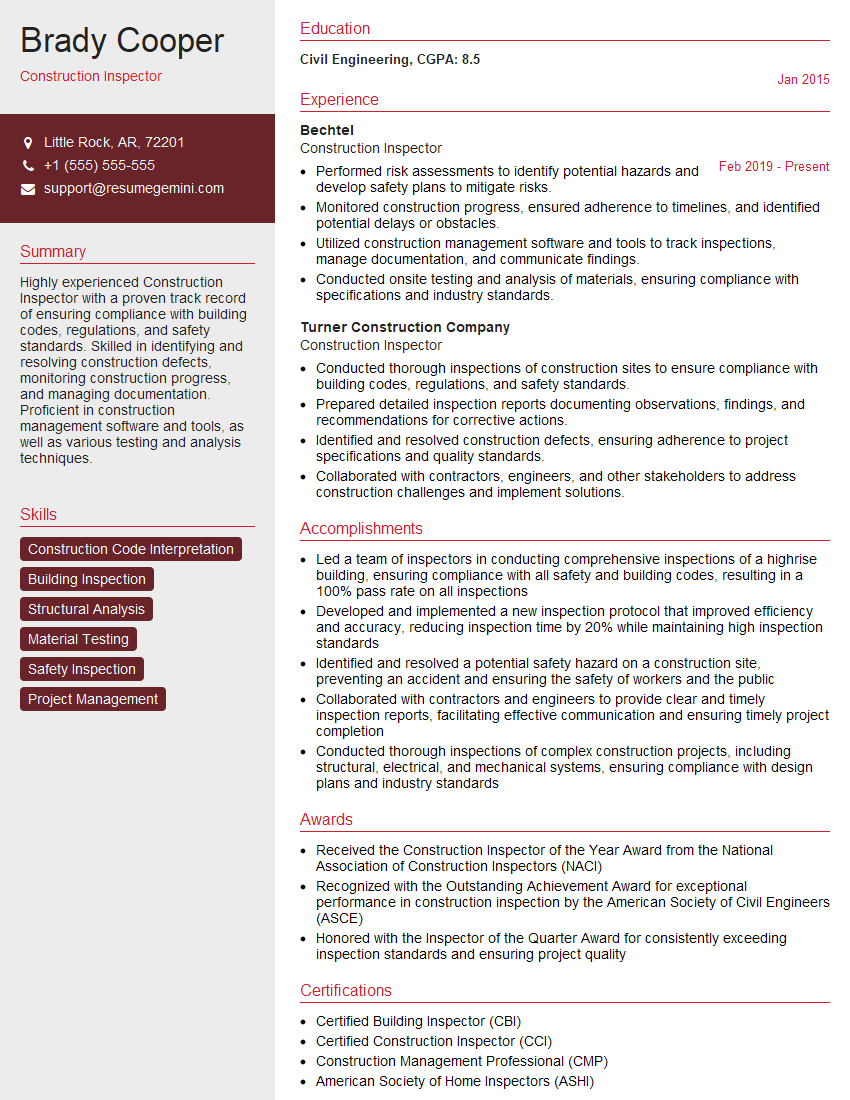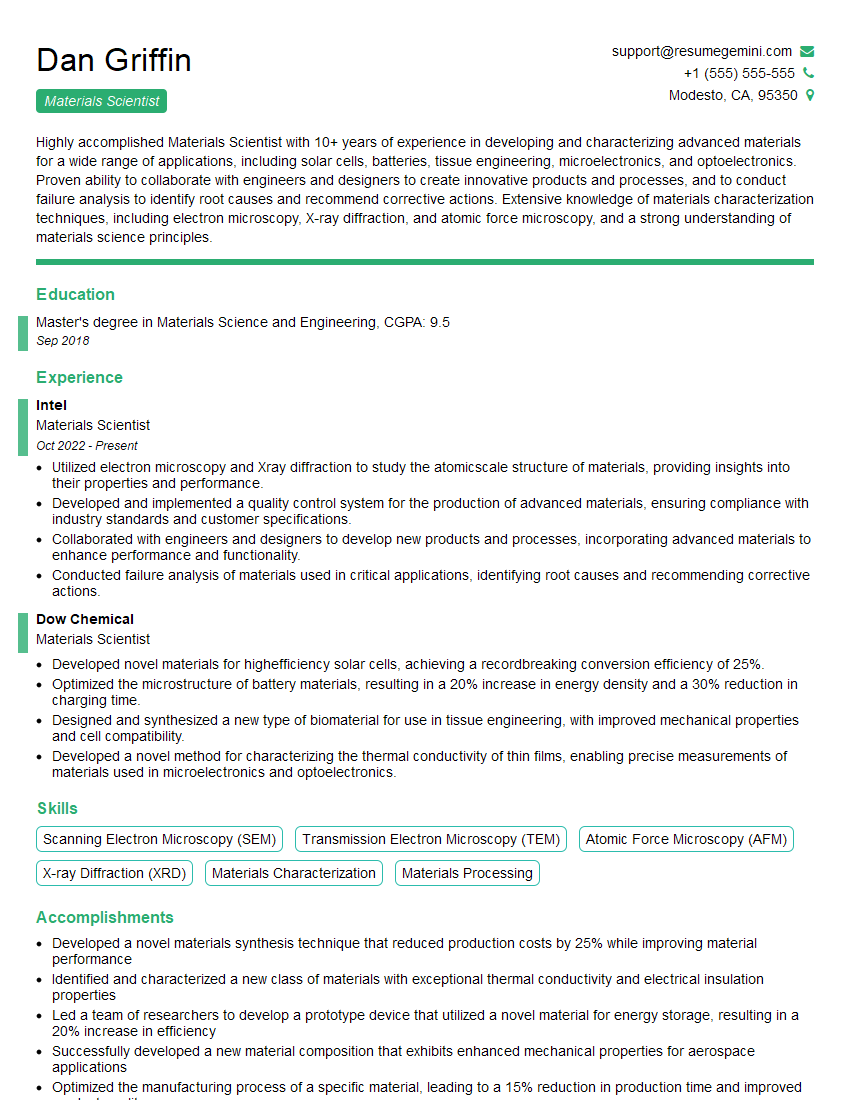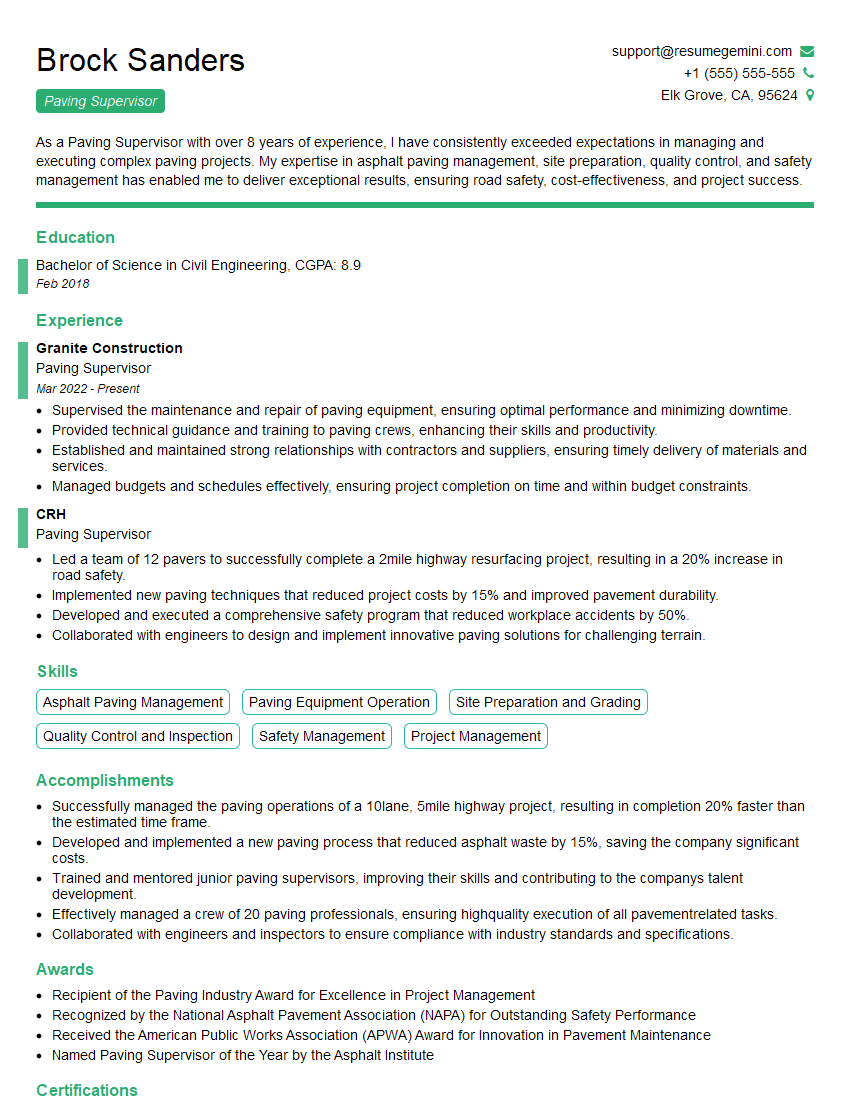Preparation is the key to success in any interview. In this post, we’ll explore crucial Knowledge of construction materials and paving techniques interview questions and equip you with strategies to craft impactful answers. Whether you’re a beginner or a pro, these tips will elevate your preparation.
Questions Asked in Knowledge of construction materials and paving techniques Interview
Q 1. What are the key differences between asphalt and concrete paving materials?
Asphalt and concrete are both widely used paving materials, but they differ significantly in their composition, properties, and application. Think of it like this: asphalt is like a flexible, dark-colored glue holding together small rocks, while concrete is a rigid, strong mixture of cement, sand, and gravel that sets like stone.
- Composition: Asphalt is a bitumen-based material mixed with aggregates (rocks and sand), while concrete is a mixture of cement, aggregates, and water.
- Flexibility: Asphalt is flexible and can withstand some movement and stress from temperature changes and traffic loads. Concrete is much more rigid and susceptible to cracking under stress.
- Durability: Both materials are durable, but asphalt generally has a shorter lifespan than concrete and requires more frequent maintenance. However, asphalt is easier and cheaper to repair.
- Cost: Asphalt is typically less expensive to produce and install than concrete.
- Application: Asphalt is often preferred for roads and parking lots, while concrete is commonly used for pavements, sidewalks, and driveways where high durability and strength are needed.
Q 2. Describe the process of asphalt paving from start to finish.
Asphalt paving is a multi-step process requiring precision and coordination. Imagine it as a carefully layered cake, each layer crucial to the final product’s strength and longevity.
- Site Preparation: This involves clearing, grading, and compacting the subgrade (the soil beneath the pavement) to ensure a stable base. Any unsuitable soil may need to be excavated and replaced with compacted fill material.
- Base Course Construction: A layer of crushed stone or other granular material is placed and compacted to provide structural support and distribute the load from traffic.
- Tack Coat Application: A thin layer of asphalt emulsion is sprayed onto the base course to provide better adhesion between the base and the asphalt surface course.
- Asphalt Paving: Hot asphalt mix is delivered and spread evenly using a paving machine. This requires precise control of the mix temperature and layer thickness.
- Compaction: The asphalt is compacted using rollers to remove air voids and achieve the desired density. This is vital for the pavement’s strength and longevity. Different rollers (static, pneumatic, vibratory) are often used at different stages.
- Finishing: The surface is smoothed and any imperfections are corrected. This may involve hand work to ensure a smooth, even surface.
- Quality Control: Throughout the process, quality control measures are undertaken to ensure that the materials meet specifications and that the construction process adheres to standards. This often involves density tests and thickness measurements.
Q 3. Explain the importance of proper compaction in paving.
Proper compaction is paramount in paving. Think of it like building a sandcastle – if the sand isn’t packed tightly, the castle will crumble. Similarly, insufficient compaction in paving leads to instability, reduced lifespan, and increased susceptibility to damage from traffic and environmental factors.
- Increased Strength and Stability: Compaction reduces air voids, increasing the pavement’s load-bearing capacity and resistance to deformation under traffic loads.
- Improved Durability: Higher density reduces water penetration, protecting the pavement from freeze-thaw damage and other forms of deterioration. Water infiltration can weaken the pavement structure from within.
- Reduced Rutting and Cracking: Proper compaction minimizes the risk of rutting (formation of depressions in the pavement surface) and cracking, extending the pavement’s service life.
- Enhanced Water Resistance: A well-compacted pavement provides better resistance to water penetration, improving its resistance to damage from freezing and thawing cycles.
Different compaction methods are used depending on the material being compacted, with various types of rollers (vibratory, pneumatic, static) used to achieve optimal density.
Q 4. What are the common types of aggregates used in concrete and asphalt mixes?
Aggregates are crucial components in both asphalt and concrete mixes. They essentially provide the bulk of the material and significantly influence the final properties.
- Concrete: Common aggregates include crushed stone, gravel, sand, and slag. The gradation (size distribution) of these aggregates is carefully controlled to ensure proper workability and strength.
- Asphalt: The aggregates used in asphalt mixes are typically crushed stone, gravel, and sometimes recycled materials. The type and gradation of aggregates significantly influence the asphalt’s performance, affecting its stability, durability, and texture.
The selection of aggregates is based on factors such as availability, cost, and performance characteristics. Testing is often conducted to assess the properties of aggregates before incorporating them into the mix.
Q 5. How do you determine the appropriate mix design for a specific paving project?
Determining the appropriate mix design is a critical aspect of paving projects. It’s like choosing the right ingredients for a recipe—the proportions must be right to achieve the desired outcome. A poorly designed mix can lead to premature failure of the pavement.
The mix design process involves several factors:
- Traffic Loading: The anticipated volume and weight of traffic will influence the strength and thickness of the pavement.
- Climate: Temperature extremes and precipitation can affect the pavement’s durability, requiring adjustments to the mix design.
- Material Properties: The properties of the available aggregates, bitumen (for asphalt), and cement (for concrete) must be carefully considered and tested.
- Performance Requirements: The desired pavement performance characteristics, such as strength, durability, skid resistance, and ride quality, must be specified.
Mix design is typically carried out in a laboratory using standardized procedures and testing methods. The process involves trial mixes to optimize the proportions of different components to meet the specified performance requirements. Computer software is frequently used to aid in mix design calculations and simulations.
Q 6. What are the different types of soil stabilization techniques?
Soil stabilization is crucial for creating a stable foundation for pavements. Weak or unstable soils can lead to pavement failure. Imagine trying to build a house on shifting sand – it simply won’t work. Soil stabilization techniques aim to improve the engineering properties of the soil to make it suitable for supporting pavement loads.
- Mechanical Stabilization: This involves methods like compaction and preloading, which increase soil density and strength. Compaction uses machinery to press down on the soil, increasing its density. Preloading involves adding a load to the soil for a period of time, allowing the soil to consolidate and settle.
- Chemical Stabilization: This involves adding chemicals such as cement, lime, or fly ash to the soil to bind the soil particles together and improve its strength and durability. This improves its strength and resistance to water.
- Thermal Stabilization: This involves using heat to alter the soil’s properties, for example, improving the bearing capacity of clay soils. This involves heating the soil which causes it to change its physical characteristics.
- Biostabilization: This is a newer method that involves using microorganisms to bind soil particles together and improve soil strength. This method promotes the growth of microorganisms which create a binding matrix in the soil.
Q 7. Describe the different types of pavement structures.
Pavement structures are designed to distribute traffic loads to the underlying subgrade. Think of it as a layered cake, each layer contributing to the overall strength and stability. The specific structure depends on factors like traffic volume, soil conditions, and budget.
- Flexible Pavements: These pavements are composed of several layers of flexible materials, such as asphalt concrete and granular materials. They accommodate traffic loads by deflecting and distributing them. They are generally less expensive but may require more frequent maintenance.
- Rigid Pavements: These pavements use a reinforced concrete slab as the primary load-bearing layer. They are very strong and durable and can withstand heavy traffic loads with minimal deflection. They are typically more expensive to construct initially but require less maintenance over their lifespan.
- Composite Pavements: These pavements combine elements of both flexible and rigid pavements to take advantage of the best features of each. For example, a layer of concrete may be placed over an asphalt base to improve strength and durability in high-traffic areas.
The design of pavement structures is based on sophisticated engineering analysis, considering the interaction between the various layers and the subgrade. Computer simulations are often used to predict pavement performance under different loading conditions.
Q 8. What are the common causes of pavement failure?
Pavement failure, unfortunately, is a common occurrence, stemming from a variety of factors acting individually or in concert. Think of it like a Jenga tower – removing one block (a contributing factor) might not cause immediate collapse, but weakening enough blocks eventually leads to failure.
- Material Deficiencies: Poor quality materials, such as weak asphalt mixes or substandard aggregates, are primary culprits. Imagine building a house with substandard bricks – it’s bound to crumble.
- Design flaws: Inadequate pavement thickness, improper drainage design, or insufficient structural capacity can lead to premature failure. This is akin to designing a bridge without considering the weight it needs to support.
- Construction Defects: Improper compaction, inadequate joint construction, or poor workmanship during installation can significantly reduce pavement lifespan. Like building a wall without proper mortar, the structure will be weak.
- Environmental Factors: Freeze-thaw cycles (water freezing and expanding in cracks), temperature variations, and aggressive chemicals (de-icing salts) contribute to material degradation and cracking. This is nature’s equivalent of weathering and erosion.
- Traffic Loading: Excessive or heavy traffic loads, particularly overloading, can exceed the pavement’s design capacity, causing cracking and rutting. Imagine a road designed for cars suddenly having to bear the weight of heavy trucks.
Identifying the root cause of failure is crucial for implementing effective remedial measures. A thorough investigation, which might include laboratory testing of materials and field observations, is often required.
Q 9. How do you assess the quality of paving materials?
Assessing paving material quality involves a multi-pronged approach, combining visual inspection with laboratory testing. It’s like a doctor performing both a physical examination and blood tests to diagnose a patient’s health.
- Visual Inspection: This involves examining the aggregates for size, shape, and cleanliness; assessing the asphalt binder for proper consistency and color; and checking for any signs of defects like segregation or voids. This initial assessment provides a quick overview of the material’s general quality.
- Laboratory Testing: More detailed analysis involves tests such as:
- Gradation Analysis: Determines the particle size distribution of aggregates.
- Specific Gravity & Absorption Tests: Measure the density and moisture content of aggregates.
- Strength and Durability Tests: Assess the compressive strength, flexural strength and resistance to freeze-thaw cycles of the pavement material.
- Asphalt Binder Properties: Tests such as penetration, softening point, and viscosity are performed to characterize the asphalt binder’s behavior.
- In-situ Tests: For already laid pavements, nuclear density gauges can measure the compaction achieved and determine if the pavement is dense enough to withstand the imposed loads.
These tests help ensure that the paving materials meet the specified requirements and will provide the necessary performance characteristics for the intended application. Failure to perform these assessments could result in a pavement that prematurely fails.
Q 10. What are the environmental considerations for pavement construction?
Environmental considerations in pavement construction are paramount. We need to minimize the impact on our planet while building durable and long-lasting infrastructure.
- Material Selection: Utilizing recycled materials (like reclaimed asphalt pavement) reduces landfill waste and conserves natural resources. Think of it as giving old materials a new life.
- Reduced Emissions: Employing low-emission equipment and optimizing construction processes minimizes greenhouse gas emissions during construction. This reduces our carbon footprint.
- Water Management: Proper drainage design prevents runoff pollution and reduces the need for de-icing salts, which can harm aquatic life. Good drainage is crucial for environmental protection.
- Noise Pollution: Implementing noise reduction measures during construction minimizes disturbances to surrounding communities. Construction can be noisy, and minimizing that noise is vital for community well-being.
- Waste Management: Proper handling and disposal of construction waste, including contaminated soil, helps avoid environmental contamination. This is a crucial aspect of responsible construction.
Sustainable pavement construction practices are becoming increasingly important as we strive towards environmentally responsible infrastructure development.
Q 11. What safety measures are crucial during paving operations?
Safety is paramount during paving operations. It’s not just about following regulations; it’s about ensuring everyone goes home safe at the end of the day.
- Traffic Control: Implementing appropriate traffic control measures, such as lane closures, detours, and warning signs, is crucial for protecting both workers and motorists. Safety is a shared responsibility.
- Personal Protective Equipment (PPE): Workers must wear appropriate PPE, including safety helmets, high-visibility clothing, safety boots, and gloves, to minimize risks of injury. This is fundamental for workplace safety.
- Equipment Safety: Regular maintenance and inspection of paving equipment are essential to prevent malfunctions and accidents. Well-maintained equipment minimizes breakdowns and injuries.
- Training and Supervision: Proper training for all personnel involved in paving operations is essential to ensure everyone understands the safety protocols and procedures. Knowledge is power when it comes to safety.
- Emergency Procedures: Having clear emergency procedures and readily available communication systems are crucial to effectively respond to accidents or incidents. Preparedness is key.
Safety is an ongoing commitment, and a proactive approach is vital in minimizing risks associated with paving operations.
Q 12. Explain the importance of proper drainage in pavement design.
Proper drainage is fundamental to pavement design. Think of it as the circulatory system of a road; without it, the road can suffer serious damage.
Water accumulation on or beneath a pavement leads to several issues:
- Structural Damage: Water can weaken the pavement structure, leading to cracking, rutting, and potholes. Think of prolonged water exposure weakening the foundation of a building.
- Frost Damage: Water freezing and expanding within the pavement structure causes significant damage in cold climates. This is similar to how water pipes can burst during freezing temperatures.
- Material Degradation: Water can accelerate the deterioration of pavement materials, particularly the base and sub-base layers. It’s like rusting in metal – water accelerates the decaying process.
- Reduced Skid Resistance: Standing water reduces tire-to-pavement friction, increasing the risk of accidents. This makes driving slippery and dangerous.
Effective drainage systems, including crown sections, gutters, culverts, and subsurface drainage layers, are essential to remove water quickly and prevent these issues. Proper drainage is a critical component in ensuring a pavement’s longevity and safety.
Q 13. Describe different types of pavement joint designs.
Pavement joints are critical for accommodating thermal expansion and contraction, minimizing cracking, and allowing for controlled movement. Think of them as expansion joints in a bridge, allowing for movement without structural failure.
- Contraction Joints: These joints, typically sawed into the pavement, allow for shrinkage during cooling. They control where cracking occurs, preventing random cracking throughout the surface.
- Expansion Joints: These are typically wider joints filled with a compressible material like asphalt filler or sealant, allowing for expansion during heating. These prevent buckling from thermal expansion.
- Construction Joints: These are formed when paving operations are stopped and resumed at a later time. They need careful design to ensure proper continuity and prevent weakness at these junctions.
- Dowel Bars: These are steel bars embedded in the pavement across joints, transferring transverse loads across the joint. They help distribute stress and prevent joint opening under load.
Proper joint design and construction are crucial for the long-term performance of pavements. Different joint types are selected based on factors like climate, traffic volume, and pavement type.
Q 14. What are the common methods for repairing damaged pavement?
Repairing damaged pavements depends on the severity and type of damage. It’s a bit like treating a patient – the treatment depends on the illness.
- Pothole Repair: Small potholes can be patched using hot-mix asphalt, ensuring proper compaction to create a smooth surface.
- Crack Sealing: Cracks are sealed with appropriate sealants to prevent water ingress and further cracking.
- Overlaying: For more extensive damage, a new asphalt layer (overlay) is added to restore the pavement surface. This is like applying a fresh coat of paint to an old house.
- Full-Depth Reconstruction: For severe damage, such as significant structural failure, full-depth reconstruction may be necessary, replacing the entire pavement structure. This is like demolishing and rebuilding a damaged building.
- Reconditioning: Methods like milling and resurfacing might be employed to remove the damaged surface layer before re-laying new asphalt to create a smooth and durable pavement surface.
Selecting the appropriate repair method is crucial for cost-effectiveness and ensuring long-term pavement performance. A thorough assessment of the damage is essential for selecting the proper repair technique.
Q 15. How do you perform a pavement condition assessment?
A pavement condition assessment is a systematic evaluation of a pavement’s structural integrity and its ability to serve its intended purpose. It involves a multi-faceted approach, combining visual inspection with more objective measurements.
Visual Inspection: This initial step involves a thorough visual survey to identify distress such as cracking (alligator cracking, longitudinal cracking, transverse cracking), potholes, rutting, raveling, and patching. Severity and extent are documented, often using standardized rating scales. For example, the International Roughness Index (IRI) measures ride quality.
Measurements: This goes beyond visual observation. It can involve using sophisticated equipment like ground-penetrating radar (GPR) to assess the pavement’s subsurface structure, identifying voids or weaknesses. Deflectometers measure the pavement’s response to load, indicating its structural capacity. Falling weight deflectometer (FWD) is commonly used. Core samples are sometimes taken for laboratory analysis of material properties (density, strength).
Data Analysis & Reporting: The collected data (both visual and measured) are analyzed to determine the overall pavement condition. This often involves classifying pavement sections into different condition ratings (e.g., good, fair, poor) and prioritizing areas requiring maintenance or rehabilitation. A comprehensive report summarizing findings and recommendations for future actions is generated.
Career Expert Tips:
- Ace those interviews! Prepare effectively by reviewing the Top 50 Most Common Interview Questions on ResumeGemini.
- Navigate your job search with confidence! Explore a wide range of Career Tips on ResumeGemini. Learn about common challenges and recommendations to overcome them.
- Craft the perfect resume! Master the Art of Resume Writing with ResumeGemini’s guide. Showcase your unique qualifications and achievements effectively.
- Don’t miss out on holiday savings! Build your dream resume with ResumeGemini’s ATS optimized templates.
Q 16. What are the factors that influence the selection of paving materials?
The selection of paving materials is a critical decision impacted by many factors, balancing cost, performance, and environmental considerations.
- Traffic Loading: High-volume roads with heavy vehicles require stronger materials like high-strength concrete or asphalt mixes with high stiffness modulus.
- Climate: Freeze-thaw cycles in cold climates necessitate materials resistant to damage from water penetration (e.g., air-entrained concrete). Hot climates require materials resistant to rutting and thermal cracking.
- Environmental Concerns: Sustainable options like recycled materials (e.g., reclaimed asphalt pavement – RAP) and permeable pavements are gaining traction due to their environmental benefits.
- Cost: Material costs vary significantly, impacting the overall project budget. Availability of local materials can also reduce transportation costs.
- Aesthetic Considerations: The desired visual appearance of the pavement (color, texture) might influence material selection, especially in areas with high pedestrian traffic or scenic locations.
- Maintenance Requirements: Some materials require less frequent maintenance than others. This factor should be considered to balance initial investment with long-term maintenance expenses.
For instance, a high-speed highway with heavy truck traffic would benefit from a robust asphalt concrete design incorporating high-quality binder and strong aggregates, while a residential street with lighter traffic might use a less expensive, thinner asphalt overlay or concrete pavement.
Q 17. Describe the different types of asphalt binders.
Asphalt binders, also known as asphalt cement, are the glue that holds the aggregate particles together in asphalt concrete. They are derived from petroleum refining and exhibit different properties based on their composition and grade.
- Performance-Graded (PG) Binders: This is the most common type, classified by a PG grade (e.g., PG 64-22). The grade indicates the binder’s performance at high and low temperatures. For example, PG 64-22 signifies that the binder performs adequately at 64°C (high temperature) and -22°C (low temperature).
- Modified Binders: These are enhanced by adding polymers (e.g., styrene-butadiene-styrene (SBS), ethylene-propylene-diene monomer (EPDM)) to improve properties like stiffness, durability, and fatigue resistance. This extends the pavement’s life and improves its performance in extreme temperatures.
- Straight Run Binders: These are less common today, representing the original, unmodified asphalt cements directly from the refinery. They typically have a narrower range of performance capabilities compared to PG or modified binders.
- Recycled Binders: These binders are reclaimed from recycled asphalt pavement (RAP) and incorporated into new asphalt mixtures. This sustainable approach reduces the need for virgin binder while often improving the mixture’s performance.
Choosing the correct binder grade is essential for ensuring the longevity and performance of the pavement. The wrong binder could lead to premature cracking or rutting.
Q 18. Explain the use of admixtures in concrete paving.
Admixtures are chemical substances added to concrete mixes in small quantities to modify its properties. In concrete paving, they play a significant role in achieving the desired workability, strength, and durability.
- Water Reducers: These allow for the use of less water in the mix without affecting workability, resulting in higher strength and durability.
- Superplasticizers (High-Range Water Reducers): These are more effective than water reducers, significantly enhancing workability and allowing for lower water-cement ratios. They are useful for high-performance concrete.
- Air-Entraining Agents: These incorporate microscopic air bubbles into the concrete, enhancing its resistance to freeze-thaw damage, a crucial factor in cold climates.
- Accelerators: These speed up the setting and hardening process of concrete, beneficial for projects with tight schedules or cold weather paving.
- Retarders: These slow down the setting process, useful for large pours or hot weather conditions where rapid setting might be problematic.
The selection and dosage of admixtures are crucial and must be carefully determined based on the project requirements, concrete mix design, and environmental conditions. Incorrect use can negatively affect the concrete’s properties.
Q 19. What is the significance of curing in concrete paving?
Curing is the process of maintaining the moisture and temperature conditions of freshly placed concrete for a specified period. It’s essential for proper hydration of the cement, which leads to the development of the concrete’s strength and durability. Think of it like allowing a plant to grow properly – it needs the right conditions to thrive.
Importance: Inadequate curing leads to incomplete hydration, resulting in reduced strength, increased porosity (making it more vulnerable to water damage and freeze-thaw cycles), and increased shrinkage cracking.
Curing Methods: Several methods exist, including:
- Water Curing: Keeping the concrete surface continuously moist by ponding, spraying, or covering with wet burlap.
- Membrane Curing: Applying a curing compound that forms a membrane to prevent moisture loss.
- Steam Curing: Used for precast concrete elements, it involves exposing the concrete to moist heat to accelerate the curing process.
The choice of curing method depends on factors such as the type of concrete, ambient conditions, and project requirements. Proper curing significantly influences the long-term performance of concrete pavements.
Q 20. What are the different testing methods for asphalt and concrete?
Testing methods for asphalt and concrete are crucial for quality control and ensuring the materials meet the specified requirements.
Asphalt Testing:
- Marshall Mix Design: This determines the optimal mix proportions of aggregates and binder for specific traffic and environmental conditions.
- Superpave Mix Design: A more advanced method using performance-related criteria, offering a more accurate prediction of pavement performance.
- Dynamic Modulus Testing: Determines the stiffness of the asphalt mixture at different temperatures and loading frequencies.
- Rutting and Fatigue Testing: These assess the resistance of the asphalt mixture to permanent deformation (rutting) and cracking (fatigue).
Concrete Testing:
- Slump Test: Measures the consistency or workability of the fresh concrete.
- Compressive Strength Test: Determines the concrete’s ability to resist crushing forces, a key indicator of strength and durability.
- Air Content Test: Measures the volume of air entrained in the concrete, critical for freeze-thaw resistance.
- Flexural Strength Test: Measures the concrete’s ability to withstand bending forces.
These tests are performed at different stages of the construction process, from material delivery to the completed pavement, to ensure quality and adherence to specifications.
Q 21. How do you manage the logistical aspects of a paving project?
Managing the logistics of a paving project requires meticulous planning and coordination to ensure materials and equipment are available at the right time and place. It’s like orchestrating a complex symphony – every element must be in harmony.
Key Aspects:
- Material Procurement: Securing timely delivery of aggregates, binder, cement, admixtures, and other materials, considering storage space and potential supply chain disruptions.
- Equipment Availability and Deployment: Ensuring that paving equipment (pavers, rollers, etc.) are operational, scheduled, and moved efficiently between work zones.
- Transportation and Traffic Management: Planning efficient transportation routes for materials and equipment, minimizing disruption to traffic and ensuring worker safety.
- Workforce Management: Recruiting, scheduling, and managing the paving crew, ensuring adequate training and compliance with safety regulations.
- Waste Management: Developing a plan for disposing of excess materials and managing construction waste in an environmentally responsible manner.
- Staging Areas: Establishing designated areas for storage of materials and equipment, ensuring efficient workflows and minimizing congestion.
Effective logistics planning is critical for project success, ensuring timely completion, cost efficiency, and minimizing delays and disruptions.
Q 22. How do you manage a paving project budget effectively?
Effective paving project budget management requires a multi-stage approach, starting long before the first shovel hits the ground. It’s not just about numbers; it’s about strategic planning and meticulous tracking.
- Detailed Estimation: We begin with a thorough site survey to accurately assess the project scope. This includes material quantities (asphalt, aggregate, etc.), labor hours, equipment rental costs, and potential unforeseen expenses (weather delays, subsurface issues). We use specialized software for accurate quantity take-offs and cost estimations.
- Contingency Planning: Unexpected challenges are inevitable. A well-structured budget always includes a contingency fund (typically 5-10% of the total cost) to absorb unforeseen issues like subsurface utilities or material price fluctuations. This prevents budget overruns and project delays.
- Regular Monitoring and Reporting: Throughout the project, we maintain a detailed tracking system. This includes daily progress reports, material usage records, and labor cost updates. This allows for proactive adjustments and identification of potential cost overruns early on. Regular meetings with the client are essential for transparency and timely decision-making.
- Value Engineering: We actively explore cost-saving strategies without compromising quality. This might involve optimizing material selection, streamlining processes, or negotiating better deals with suppliers. For instance, using recycled asphalt can significantly reduce material costs without sacrificing performance.
For example, on a recent project, meticulous planning and a robust contingency fund allowed us to seamlessly handle a subsurface rock encounter that was not identified during the initial survey. This prevented significant delays and cost overruns.
Q 23. Explain different methods of pavement marking.
Pavement marking is crucial for road safety and traffic flow. Several methods exist, each with its own advantages and disadvantages:
- Thermoplastic Paint: This is a popular choice due to its durability and long lifespan, particularly in high-traffic areas. It’s applied hot and adheres well to the pavement surface. It also offers excellent reflectivity at night.
- Cold Paint: This method uses pre-mixed paint applied cold, typically using spray equipment. It’s quicker and easier to apply than thermoplastic paint but tends to have a shorter lifespan and lower durability compared to thermoplastic.
- Preformed Tape: Preformed thermoplastic tape offers high durability and reflectivity. It’s pre-manufactured to specific dimensions and designs, offering clean, consistent lines. It is particularly useful for complex designs or curved lines.
- Raised Pavement Markers (RPMs): These are raised markers embedded in the pavement, providing tactile feedback and visual guidance, particularly beneficial for low-visibility conditions or for guiding drivers in areas where visual markings may be less effective.
The selection of the marking method depends on factors such as budget, traffic volume, pavement type, and desired lifespan. For instance, a highway would benefit from durable thermoplastic paint or preformed tape, while a low-traffic residential street might suffice with cold paint.
Q 24. Describe the impact of temperature on asphalt paving.
Temperature significantly impacts asphalt paving. Asphalt’s viscosity (thickness) is highly temperature-dependent. This affects its workability and long-term performance.
- High Temperatures: High temperatures make the asphalt too fluid, making it difficult to control during placement and potentially leading to segregation (separation of aggregate from binder). This results in uneven pavement surfaces and reduced durability.
- Low Temperatures: Low temperatures make the asphalt too stiff, hindering compaction and leading to a rougher surface finish. Cold weather can also delay the curing process, weakening the pavement’s structure.
Therefore, maintaining optimal temperature ranges during both mixing and paving is crucial. This requires precise control over the asphalt plant and the paving equipment. Advanced pavement design often incorporates strategies such as using different asphalt grades tailored to regional temperature variations. We might even use infrared thermometers to monitor asphalt temperature in real-time during paving operations to ensure we’re within the optimal working range for that specific asphalt.
Q 25. What are the different types of pavement rehabilitation techniques?
Pavement rehabilitation techniques aim to restore the structural integrity and ride quality of existing pavements. The choice of technique depends on the severity of the pavement damage:
- Crack Sealing: This addresses small cracks to prevent water infiltration and further deterioration. It’s a cost-effective solution for early-stage pavement distress.
- Patching: This involves removing damaged sections of the pavement and replacing them with new material. It’s appropriate for localized damage like potholes or rutting.
- Overlaying: This involves placing a new layer of asphalt or concrete over the existing pavement. It extends the pavement’s life and improves its surface condition. This is suitable for more widespread deterioration.
- Reconstruction: This is the most extensive rehabilitation method, involving the complete removal and replacement of the existing pavement structure. It’s necessary when the pavement is severely deteriorated beyond repair by other methods.
- Full-Depth Reclamation (FDR): This in-situ recycling method uses specialized equipment to break up and mix the existing pavement with stabilizing agents (like cement or lime) to create a new base for a new asphalt layer. This method is cost-effective and minimizes environmental impact compared to complete pavement removal.
For example, a pavement with extensive cracking might benefit from an overlay, while a pavement with significant potholes and rutting would likely require patching or full-depth reclamation before an overlay.
Q 26. How do you select appropriate equipment for paving operations?
Equipment selection for paving operations is critical for efficiency, safety, and quality. The choice depends on several factors, including project size, pavement type, and site conditions.
- Paving Machines (Pavers): The type of paver (slip-form, wheel, etc.) is determined by the pavement type (asphalt, concrete) and the project scale. Larger projects often utilize larger capacity pavers for better productivity.
- Rollers (Compactors): Different types of rollers (static, vibratory, pneumatic) are needed for different pavement layers and materials. Vibratory rollers are essential for compacting asphalt layers for optimal density.
- Material Transfer Equipment: This includes trucks, conveyors, and hoppers for efficient transportation and supply of materials to the paving machine. Efficient material handling minimizes downtime.
- Support Equipment: This includes equipment for excavation, grading, and finishing operations, such as graders, loaders, and milling machines.
For instance, a large highway project would require high-capacity pavers and efficient material transport equipment, while a smaller residential project might use a smaller paver and manual material handling. We always prioritize equipment that meets safety standards and has a proven track record of reliability.
Q 27. How do you deal with unexpected issues during a paving project?
Unexpected issues are common in paving projects. Effective management requires a proactive approach and a well-defined plan for handling unforeseen circumstances.
- Thorough Site Investigation: A comprehensive site survey helps identify and mitigate potential problems before they arise. This minimizes surprises and enables proactive planning.
- Risk Assessment and Mitigation: We identify potential risks (e.g., unexpected utilities, weather delays, material shortages) and develop contingency plans. This includes having backup materials and equipment readily available.
- Effective Communication: Open communication with the client, subcontractors, and project team is essential. This ensures everyone is aware of the situation and contributes to finding solutions.
- Problem-Solving Skills: We employ a structured problem-solving approach, involving analyzing the issue, generating solutions, evaluating options, and selecting the best course of action. This could involve adapting the work plan or seeking expert advice.
For example, on a recent project, we encountered unexpected subsurface utilities. Our risk assessment plan had anticipated this possibility. We immediately contacted the utility company, coordinated the relocation of the utilities, and adjusted the project schedule to accommodate the delay, minimizing the impact on the overall project timeline and budget.
Q 28. What is your experience with different paving equipment?
My experience with paving equipment is extensive. I’ve worked with a wide range of machines, from small, hand-guided pavers for residential driveways to large, high-capacity pavers for major highway projects. I’m proficient in operating and maintaining various types of rollers, including vibratory, static, and pneumatic rollers. My expertise also includes using milling machines for pavement removal and repair, as well as loaders and graders for site preparation.
I have experience with various manufacturers’ equipment and understand the strengths and weaknesses of different models. This experience allows me to make informed decisions on equipment selection for different project needs and to optimize paving operations for efficiency and quality. For instance, I’m familiar with the operation and maintenance procedures for asphalt pavers from manufacturers like Caterpillar, Vögele, and Dynapac, and I can effectively troubleshoot and resolve issues with these machines. I’m also experienced in the use of various compaction equipment, including Hamm, Bomag, and Ingersoll Rand rollers, ensuring optimal pavement density and reducing future maintenance requirements.
Key Topics to Learn for Knowledge of Construction Materials and Paving Techniques Interview
- Material Properties: Understanding the physical and chemical properties of various paving materials (asphalt, concrete, aggregates, etc.), including strength, durability, permeability, and workability. Consider how these properties impact performance and longevity.
- Paving Design and Construction: Familiarize yourself with different paving design methods, including base preparation, sub-base design, and pavement structure. Understand the practical application of these designs in various contexts (e.g., highways, residential streets).
- Pavement Construction Techniques: Master the practical aspects of paving, including equipment operation (pavers, rollers, etc.), quality control procedures, and compaction techniques. Be prepared to discuss different paving methods (e.g., hot-mix asphalt, cold-mix asphalt, concrete paving).
- Material Selection and Specifications: Learn how to select appropriate materials based on project requirements, budget, and environmental considerations. Understand industry standards and specifications for different paving materials.
- Quality Control and Testing: Become familiar with various testing methods used to ensure the quality of paving materials and the completed pavement structure. Understand the importance of quality control in preventing premature pavement failure.
- Sustainability and Environmental Considerations: Explore environmentally friendly paving materials and construction techniques. Be prepared to discuss the impact of paving on the environment and potential solutions for minimizing negative effects.
- Problem-Solving and Troubleshooting: Practice identifying and solving common problems encountered during paving projects, such as pavement cracking, rutting, and surface irregularities. Be ready to discuss your approach to troubleshooting and preventative maintenance.
Next Steps
Mastering knowledge of construction materials and paving techniques is crucial for career advancement in the construction industry. A strong understanding of these topics demonstrates technical expertise and problem-solving skills, opening doors to more senior roles and higher earning potential. To maximize your job prospects, crafting an ATS-friendly resume is essential. ResumeGemini is a trusted resource that can help you build a compelling and effective resume. We offer examples of resumes tailored to showcasing expertise in knowledge of construction materials and paving techniques, providing you with a competitive edge in your job search. Take the next step towards your dream career – build your best resume with ResumeGemini.
Explore more articles
Users Rating of Our Blogs
Share Your Experience
We value your feedback! Please rate our content and share your thoughts (optional).
What Readers Say About Our Blog
Hi, I have something for you and recorded a quick Loom video to show the kind of value I can bring to you.
Even if we don’t work together, I’m confident you’ll take away something valuable and learn a few new ideas.
Here’s the link: https://bit.ly/loom-video-daniel
Would love your thoughts after watching!
– Daniel
This was kind of a unique content I found around the specialized skills. Very helpful questions and good detailed answers.
Very Helpful blog, thank you Interviewgemini team.
